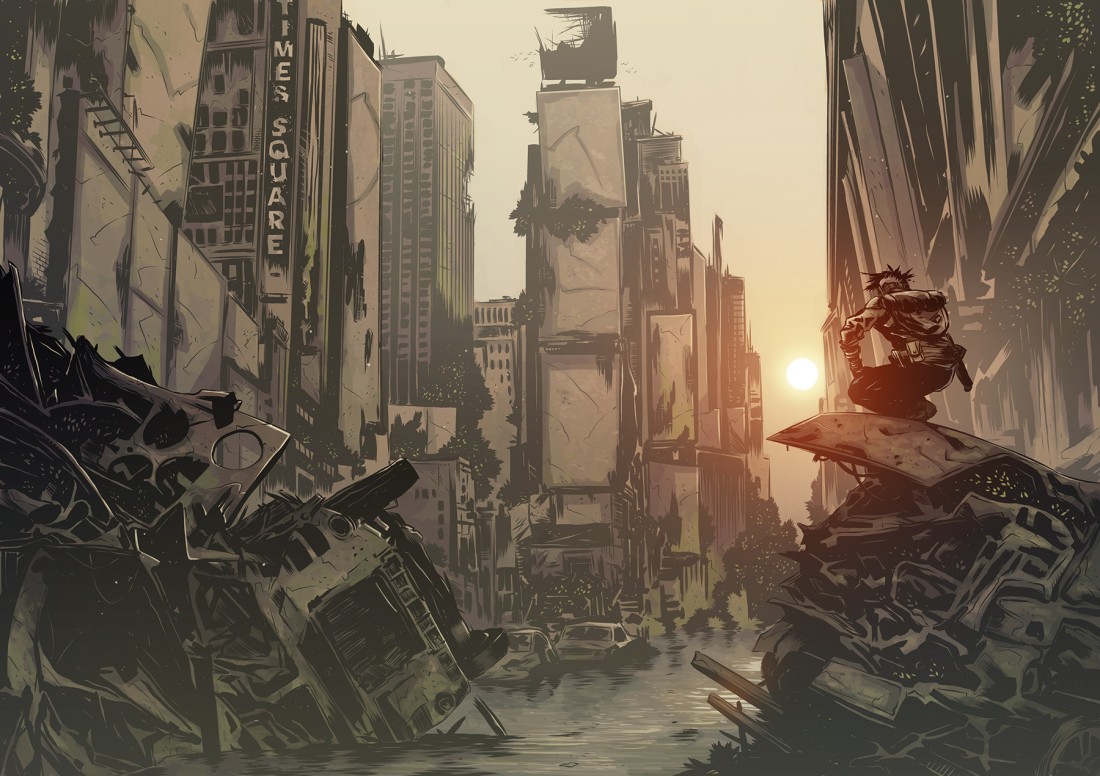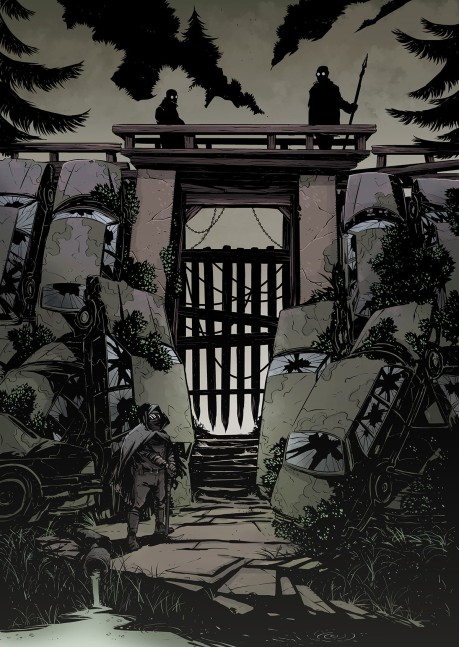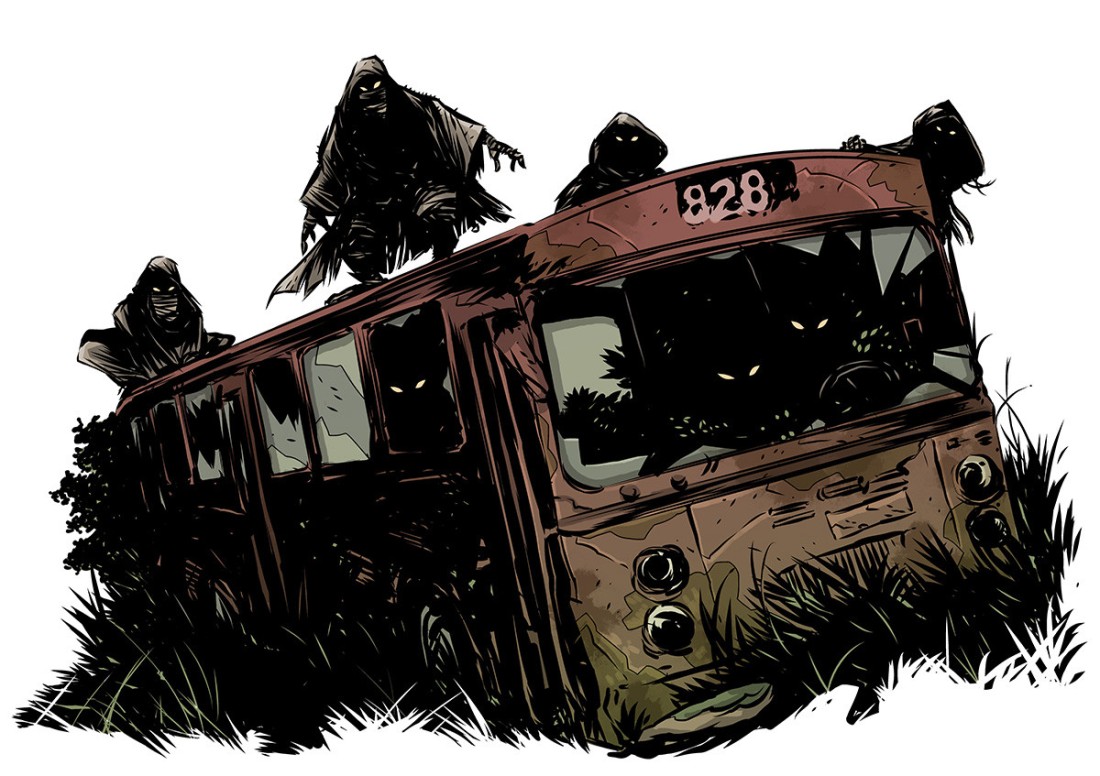 I’ll start this by saying that if you’ve made it this far you owe it to yourself to have a look at Mutant: Year Zero, the post-apocalypse RPG published by Modiphius a couple of years ago. Go online and find whatever preview freebie you can get, or (better yet) flip through a copy at your local game store. For my money it’s the most thoroughly enjoyable post-apocalyptic themed RPG to come out since D. Vincent Baker’s Apocalypse World (about which more later).
I’ll start this by saying that if you’ve made it this far you owe it to yourself to have a look at Mutant: Year Zero, the post-apocalypse RPG published by Modiphius a couple of years ago. Go online and find whatever preview freebie you can get, or (better yet) flip through a copy at your local game store. For my money it’s the most thoroughly enjoyable post-apocalyptic themed RPG to come out since D. Vincent Baker’s Apocalypse World (about which more later).
Instead of writing a general review of M:YZ, I’m going to do something a little different. I want to talk about how M:YZ effortlessly blends new-school and old-school, story-game and traditional game, into a very tasty gaming treat.
In Mutant: Year Zero you play Mutants trying to eke out a living in a blasted post-apocalyptic landscape. You cling to life in a community, your Ark, where an Elder has guided the life of the community for as long as you can remember. But the Ark is no paradise, and not even that much of a safe haven. The Elder is on his last legs, the food’s running out, and the People (as you call yourselves) are dying off; there’s never been a single baby born in the Ark. It’s in that context that you and the other PCs brave the Zone, and all its myriad threats, to find resources and to dig up answers about your past.
If you want more context than that before you dive in here, please have a look at Lowell Francis’ thorough review on his blog Age of Ravens. (You might not want to come back, but that’s okay. Lowell’s work is topnotch.)
So about this traditional game and story-game business, why should I care?
Right.
Let’s say you’ve got a regular group with a lot of trad gamers and they’re not interested in anything that looks even remotely like it might be a story-game. Bring your big, lovingly produced copy of Mutant: Year Zero to your next session, and they might sing a different tune. Or maybe you’ve done a lot of traditional gaming over the years, but you’d like to test the waters out with something not as daunting and different as the trade paperback-sized games you see over in the cool kids’ rack at the game store.
Call it a gateway game, a Trojan Horse, or whatever, Mutant: Year Zero is one of the best games for bridging the narrative/traditional gamer divide that I’ve had the good fortune to come across. So, let’s get out there and build some bridges, people!
Okay, now that I’m off my soapbox, I’ll get down to some cases…
 Peanutty Narrative Game Goodness
Peanutty Narrative Game Goodness
[When I refer to narrative or story games, I’m talking about games that (and I’m speaking very broadly here) build their mechanics to focus on the unfolding story of the game, rather than mechanically simulating aspects of the game world. These sorts of games have steadily gained popularity in the hobby since the mid-2000s. If you’ve played Fiasco, Dread, Microscope, Dogs in the Vineyard, or any of the growing number of Powered by the Apocalypse (PbtA) titles, then you’ve played a story-game.]
On the sheets for the various character roles for M:YZ there are a number of things that will jump off the page if you’ve played any PbtA titles. There’s a list of names to choose from; various suggested descriptors for Face/Body/Clothing; and a block where you choose a special relationship with one other PC (and one NPC). While I don’t think this kind of narrative “pre-seeding” of names and relationships originated in the PbtA design space, I’m fairly certain it comes from the story-game side of things.
Getting Experience (XP), is part of playing M:YZ, so score one for the Trad Game side of things, but, BUT, you only get experience from the following: doing a Day’s Work for an Ark project, making progress towards realizing your character’s Big Dream, exploring at least one new Zone Sector, sacrificing or risking something for your PC buddy, and sacrificing or risking something for that special NPC you want to keep safe. So, you can kill Zone Ghouls, et al, all day long, but it’s not going to help your character advance in the game.
Tough Character Decisions
To me a hallmark of story-gaming is that your character can’t have it all. There’s no way to power-game your way to invulnerability. Many of the games that I like best come with difficult decisions and balancing acts baked right into the mechanics.
This is never more true, or more appropriate, than in a game that focuses on survival. In M:YZ you must:
– Decide whether to keep that cool artifact that you found, or contribute it to the dawnvault where it will improve the characteristics of the Ark;
– Use your powerful Mutant Powers to survive, knowing that they will eventually wear your body out;
– Choose whether to use the precious Bullets you have to shoot something (or someone), or use them to buy things like Grub and Fresh Water that will keep you alive. I doubt the M:YZ design team was thinking about this, but this mechanic is an excellent implementation of comedian Chris Rock’s “Bullet Control” concept.
Shadows of Apocalypse World
I can also see very specific strands of DNA from D. Vincent Baker’s groundbreaking design for Apocalypse World woven into Mutant: Year Zero.
The Ark, with its many potential conflicts and social entanglements, could easily be a Hardhold from Apocalypse World; the Ark’s many bosses trying to usurp the Elder’s power echo Apocalypse World’s NPCs trying to undermine, or knock off, a Hardholder. In fact, most of the things likely to go on in the Ark (jockeying for social position, NPCs playing characters off of each other, misfortunes that reshape the hierarchy) would be the bread and butter of an Apocalypse World session.
Even the implementation of some of the Mutant: Year Zero Skills reflects their counterparts in Apocalypse World’s Move structure.
Take, for example, the Go Aggro move from Apocalypse World (1st Edition)…
When you go aggro on someone, roll+hard. On a 10+, they have to choose: force your hand and suck it up, or cave and do what you want. On a 7–9, they can instead choose 1:
– get the hell out of your way
– barricade themselves securely in
– give you something they think you want
– back off calmly, hands where you can see
– tell you what you want to know (or what you want to hear)
Compare this to the Enforcer’s Intimidate skill from M:YZ.
Everyone in the Ark knows you’re bad news. Often you don’t even need to hit anyone to make them back down. You know exactly which buttons to push to subdue them – or provoke them. Roll for Intimidate when you use your sheer physical presence to get someone to do what you want.
Failure: He won’t be pushed around by a bully like you. He might even attack you now, or hold the grudge for the opportune moment.
Success: Your opponent must choose – either attack you right now (by Fighting, Shooting or using a mutation), or bow to your will.
Both mechanics carry the idea of pushing the story forward by forcing the subject of the action to fight right now or submit.
Chocolaty Trad Flavor
Fear not traditional gamer, there’s some crunch skillfully woven into Mutant: Year Zero, too. You’ll find much that’s familiar to you. You get Abilities, Talents, Gear, Mutations, etc., and a d6-based engine to make it all go. There’s even a light, but effective, encumbrance system. (Encumbrance as a game mechanic can be traced right back to the earliest iterations of D&D.) These kinds of systems are typically more honored in the breach than in the observance, but in M:YZ it fits perfectly with the theme. It asks the question: what’s really worth lugging around the wasteland?
If playing scenes in the Ark is analogous to the flavor and style of Apocalypse World, then the Zone fairly drips with the stuff of more traditional games, particularly TSR’s old school classic Gamma World. It takes the traditional Hexcrawl and streamlines it into an exciting sub-game that perfectly balances the social tension in the Ark. There are funky mutant creatures, cults, and environmental hazards that want to chew your characters up and spit them out. There are plenty of ways to die out in the Zone and lots of tough choices for characters to make along the way.
Mutant: Year Zero also has the high production values that the trad gamer has come to expect thanks to the likes of Wizards of the Coast, Paizo, Fantasy Flight Games, and others. The M:YZ core book runs to 272 pages in the familiar 8.5 by 11 format that’s just dripping with full color theme. And you can trick your game out with a slickly produced GM screen, a box of cards to simplify in-game book-keeping, and a set of lovely (optional) dice.
Two Great Tastes That Taste Great Together? 
Sadly, I still haven’t gotten to play M:YZ yet, but the carefully blended and balanced system is right there on the page. It’s got action, intrigue, social drama, high stakes, and high weirdness… everything I could want from a product at this point in my long gaming career.
Your mileage may vary, of course, when it comes to the actual play experience. In default mode, Mutant: Year Zero has a tone that’s roughly equivalent to The Walking Dead TV series. I’ll modulate that by saying that I don’t think it’s quite that bleak, but your players should be ready to see their characters die. If you’re using the game as designed, there’s almost no way every original character (or possibly any original character) will see the silver-lining of the game’s Metaplot come to fruition. As in a Call of Cthulhu campaign, it may take a few generations of brave and unlikely heroes to make it to the end.
If character death is the sort of thing your group gets all twisted up about, then this isn’t for them. But if it’s for you, find someone, somewhere to play with, because I think Mutant: Year Zero is just about the perfect flavor of grown-up fun.

Lovely blog you have heree
LikeLike